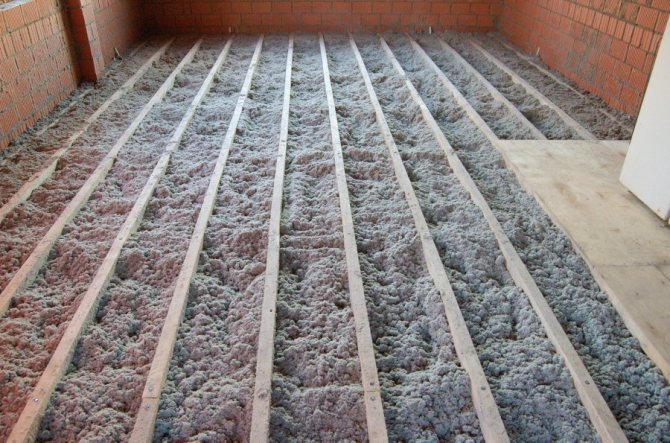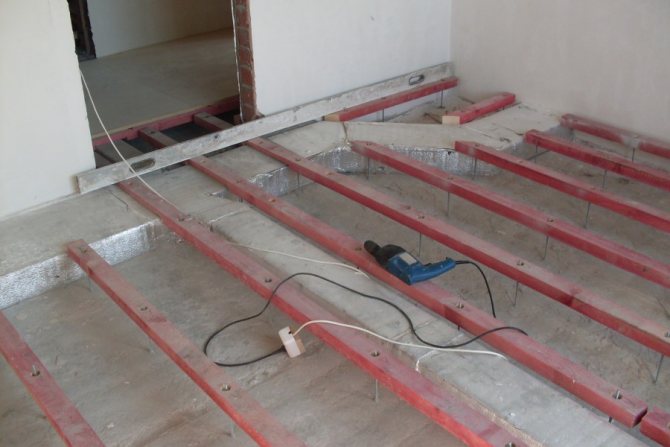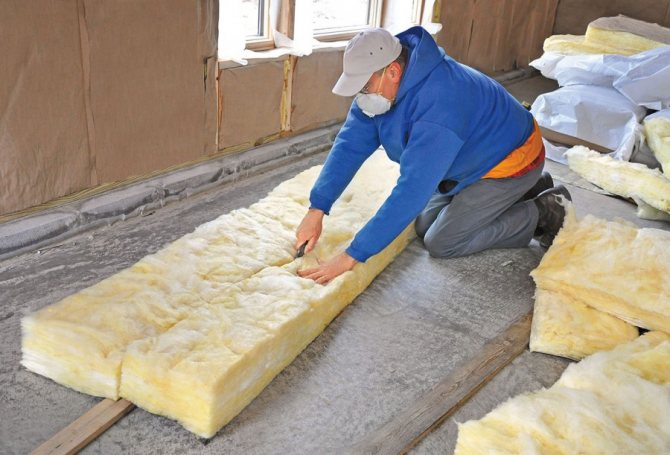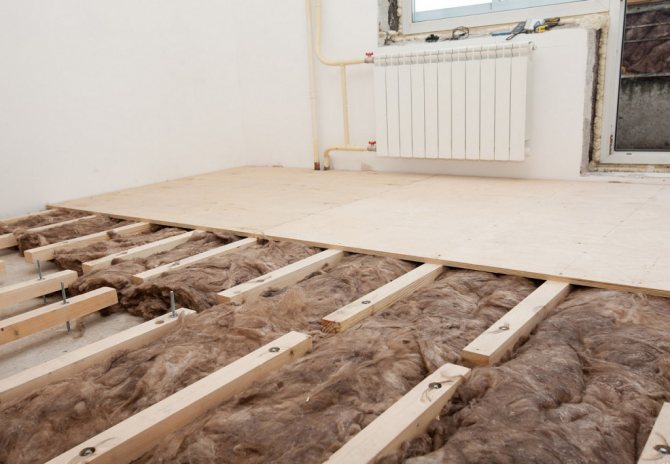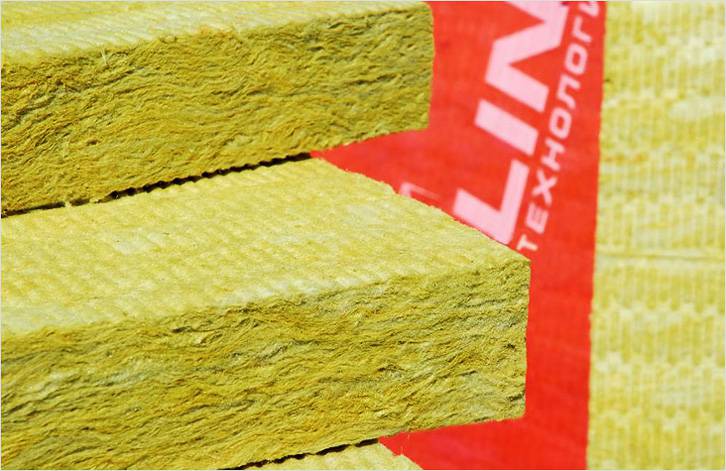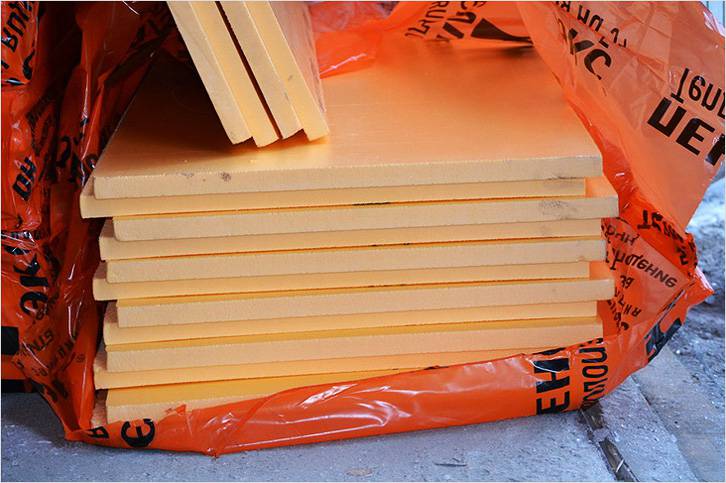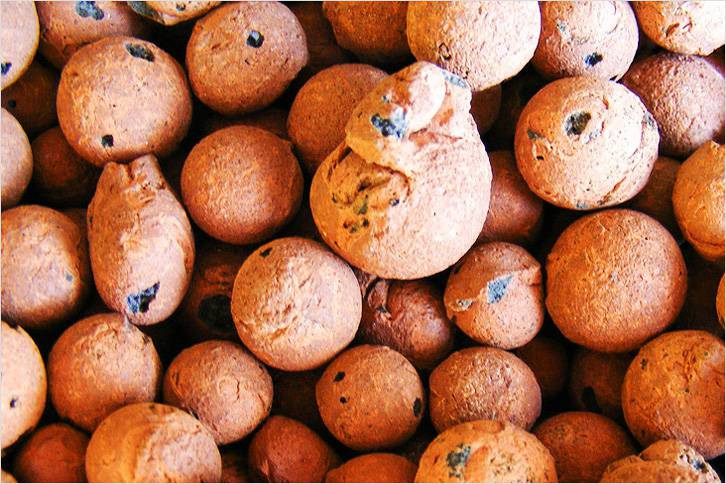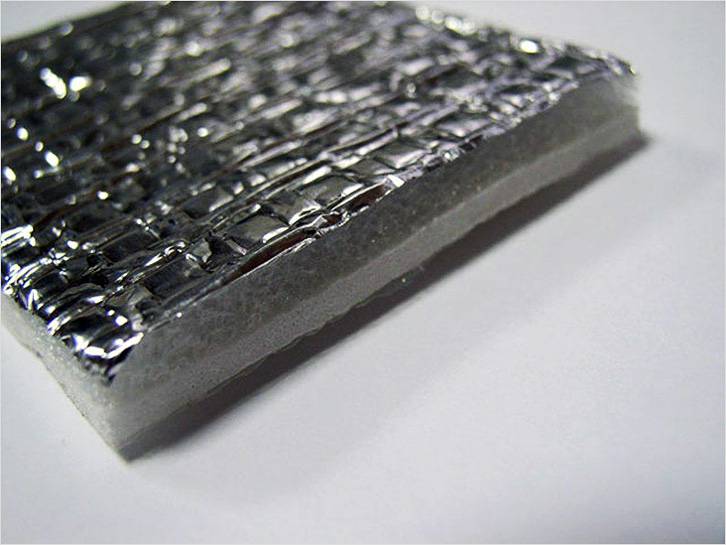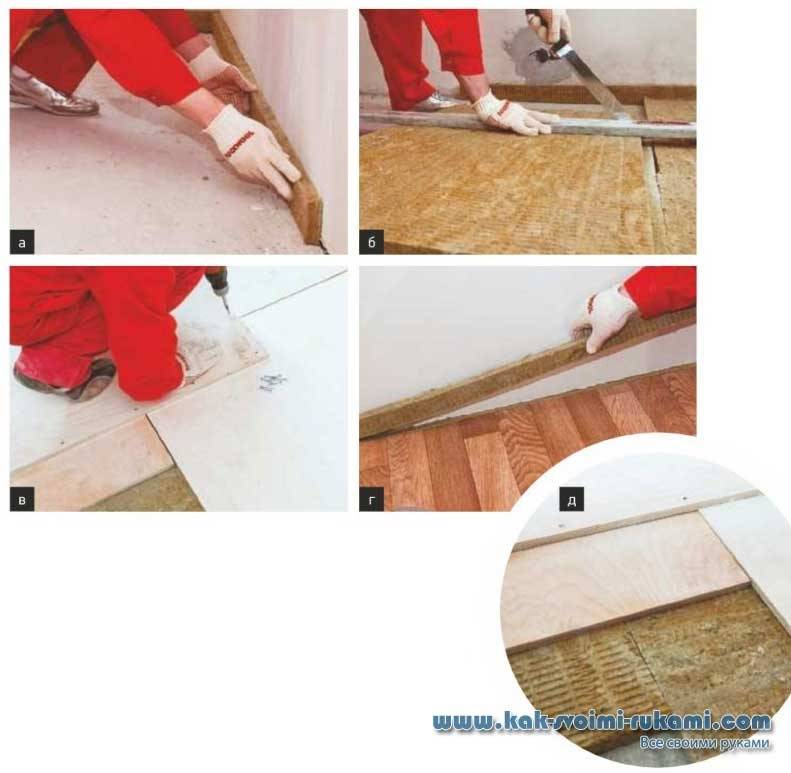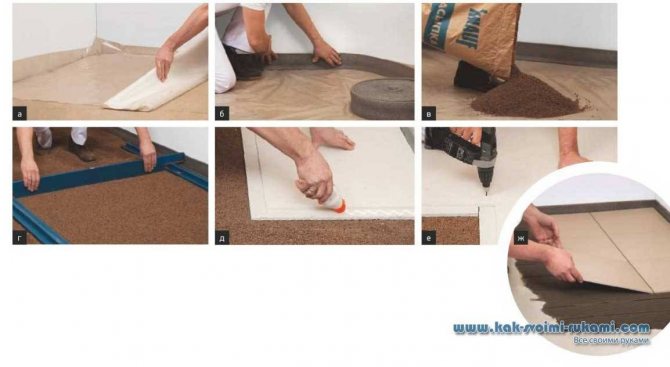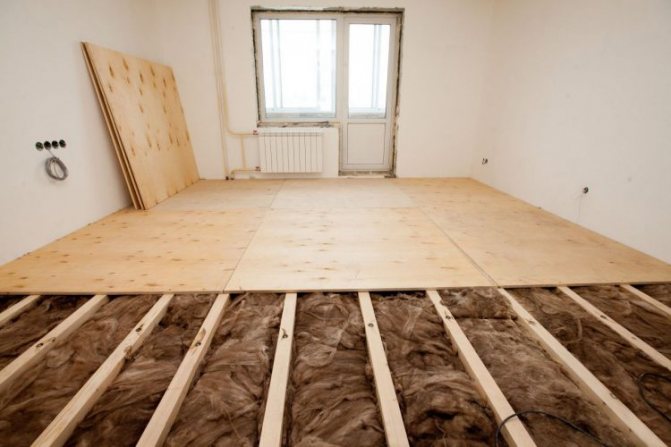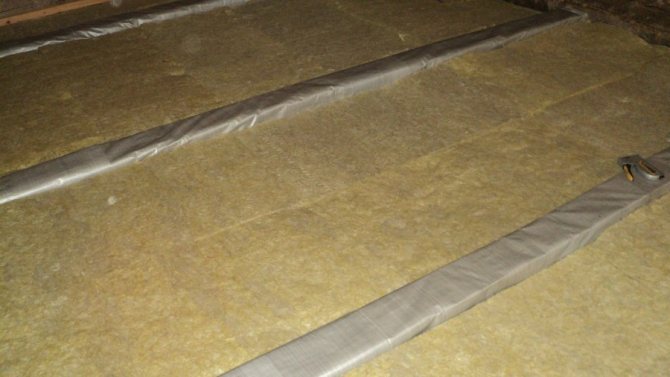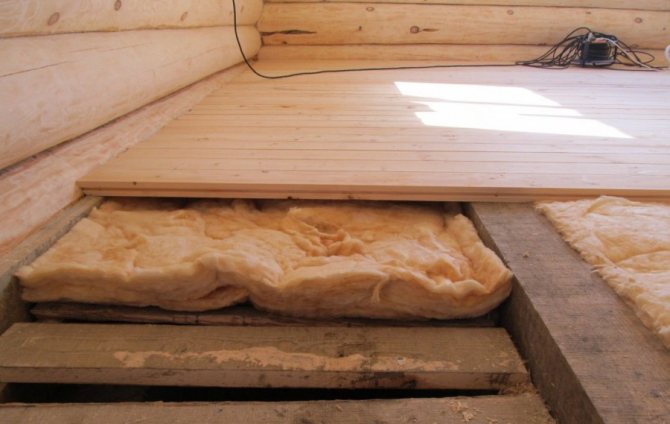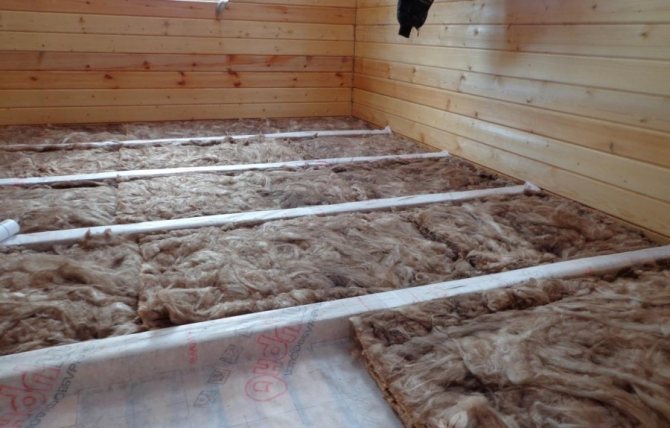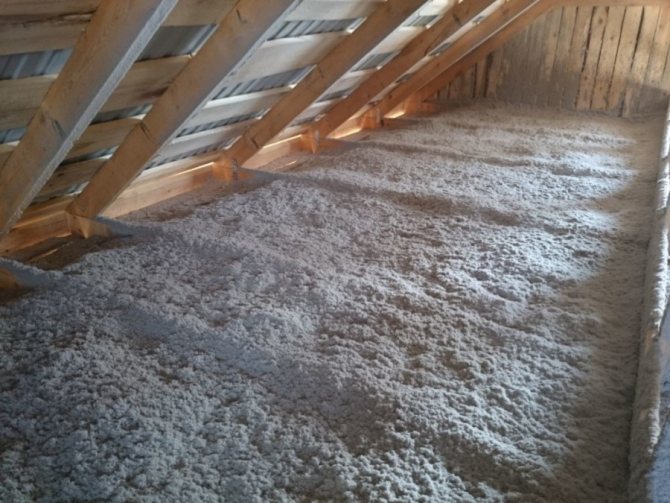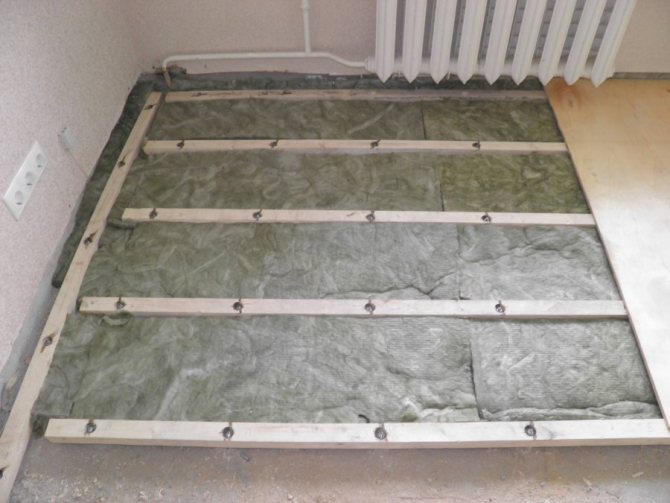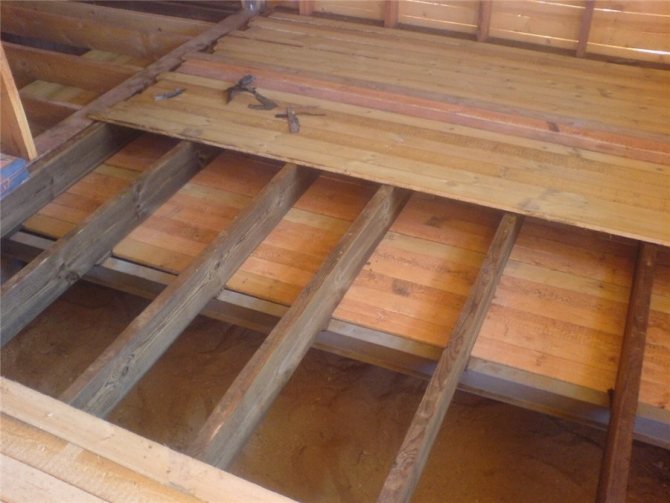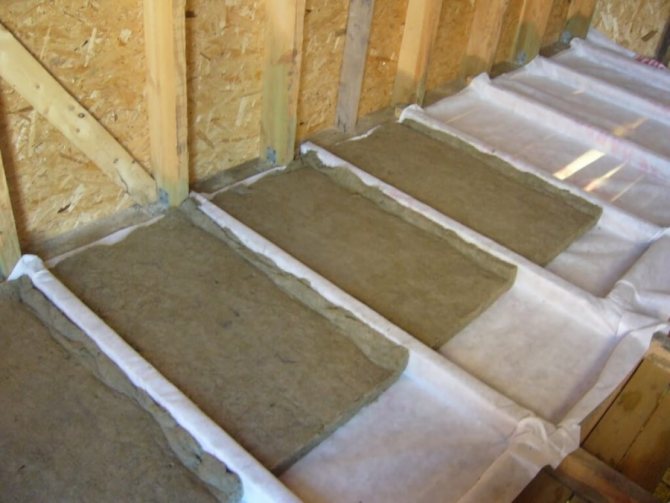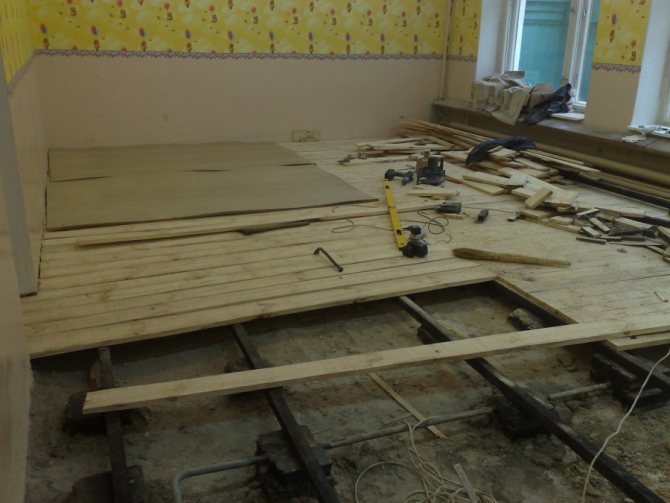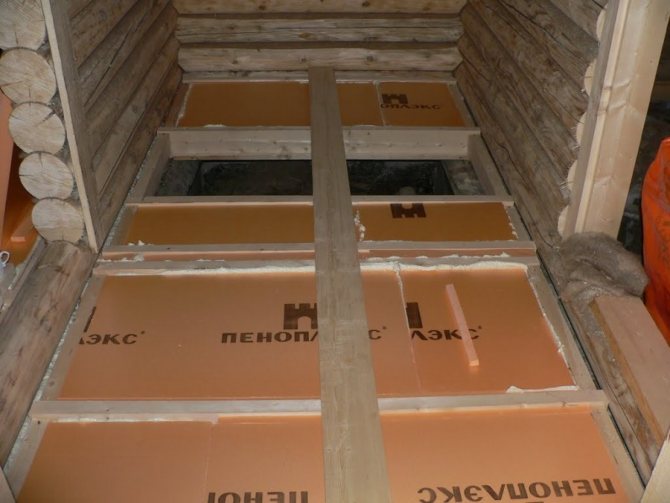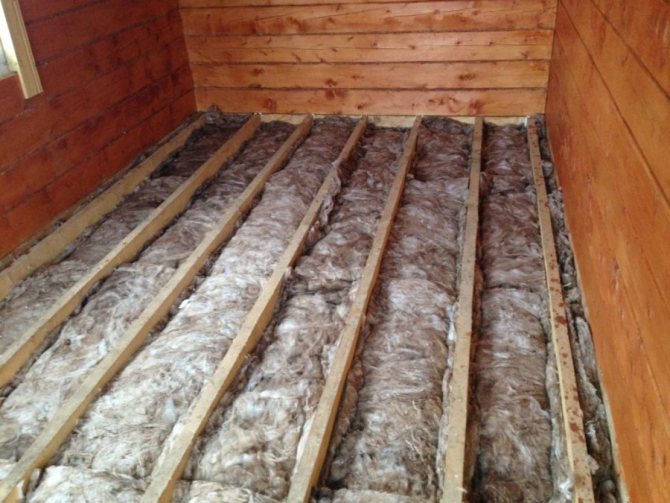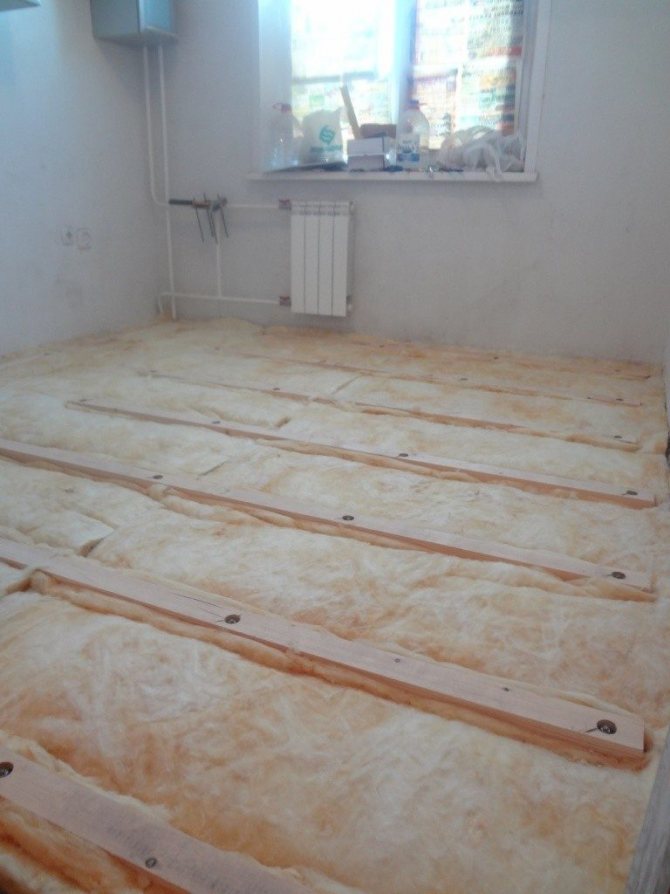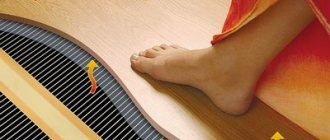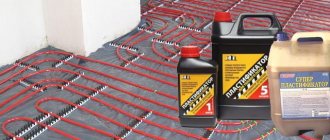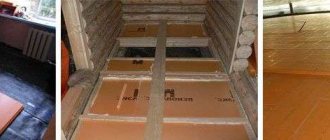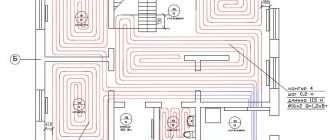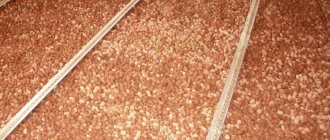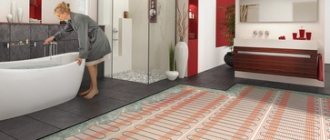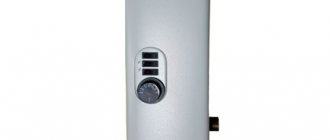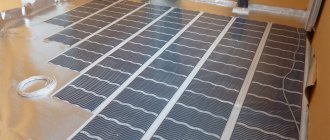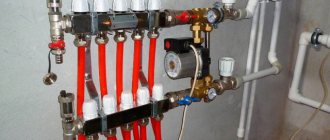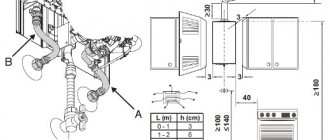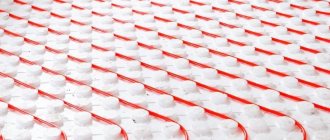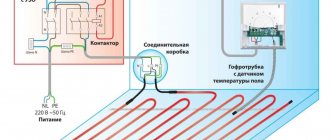When performing major repairs in an apartment, you should not limit yourself to performing an even screed on concrete slabs. An important issue is to solve the problem of a high-quality soundproofing layer.
The main goals of floor sound insulation are to maximize the level of noise penetrating into the apartments located on the floor below and to protect against noise generated by the neighbors below. Noise sources, their characteristics and noise standards are determined by SNiP 23-03-2003. This document was developed using the following regulatory documents: GOST 17187-81, GOST 27296-87, SP 23-103-2003, SNiP 2.07.01-89.
The traditional solution to this problem is to lay resilient materials such as linoleum or carpet. However, it is impossible to completely solve the issue of high-quality soundproofing of the floor from the lower neighbors in this way.
System "floating floor" - one of the options for soundproofing the floor
One of the ways to solve not only the problem of soundproofing the floor, but a number of other, no less important tasks, allows the "floating floor" system.
The term "floating floor" means a multi-layer floor covering that does not have a rigid connection with the floor. The elastic materials used in the construction effectively absorb vibration and prevent the transmission of sound into the room located below.
Although there are quite a few options for installing a floating floor using a wide range of materials, there are three main types of it: concrete floating floors, prefabricated and based on a dry screed.
A natural question arises: why use such a rather complex system, if there are traditional, simpler methods of soundproofing? The reason for the popularity of floating floor technology is due to the following reasons:
- it the most effective floor sound insulation technology.
- One of the layers of the floating floor is a heat-insulating material, most often mineral wool, which makes it possible to increase the level of heat saving in an apartment.
- Technologies "prefabricated floor" and "dry screed" simplify and speed up installation work as much as possible, since they are carried out without time-consuming "wet" processes.
- The use of such a soundproofing system makes it possible to install heating elements for an electric or water "warm floor".
- Floating floors can be installed both during construction and during renovation.
- The system perfectly solves the problem of eliminating floor irregularities.
Options for floor insulation under the screed: laying procedure
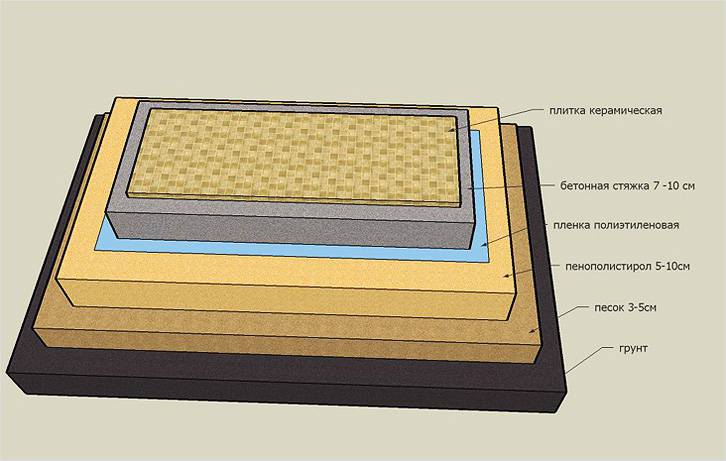
The scheme of insulation on the ground with penoplex
Insulation under the screed with foam and polystyrene foam. In the process of building the floor, a pillow is prepared to begin with. For this, a layer of gravel is evenly laid and then pressed. Then a pillow of sand is poured, which is also pressed. After these operations, a concrete screed is poured over the ground onto the reinforcing cage. The prepared floor can or may not be covered with waterproofing, since expanded polystyrene itself performs the function of waterproofing. A damper tape is installed along the edge of the room. The next layer is laid out with insulation. In most cases, it is staggered. Further, the sheets of insulation are poured with a concrete screed.
Video: laying foam under the screed
Video: how to make a screed on expanded polystyrene
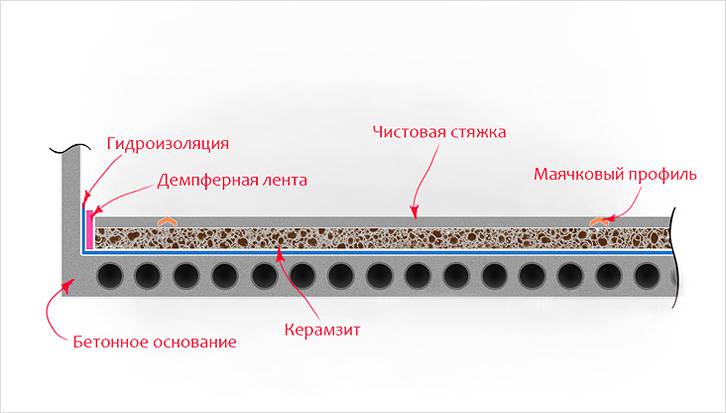

Thermal insulation of the floor with expanded clay - pie
Warming expanded clay... First of all, the concrete coating or soil is covered with a vapor barrier material.Further, the area is covered with expanded clay of different fractions (to achieve maximum thermal insulation efficiency). The finished layer is treated with cement milk. After the completion of the above operations, the insulation is poured with a cement screed over the reinforcing mesh.
Note!
This type of floor acquires its strength properties not earlier than a month after installation.
Video: floor screed technology with expanded clay
We have already talked about insulation with foil insulation. Its use is impractical for a floor screed, even in combination with a floor heating system. See what happens to the foil a month after the screed is poured.
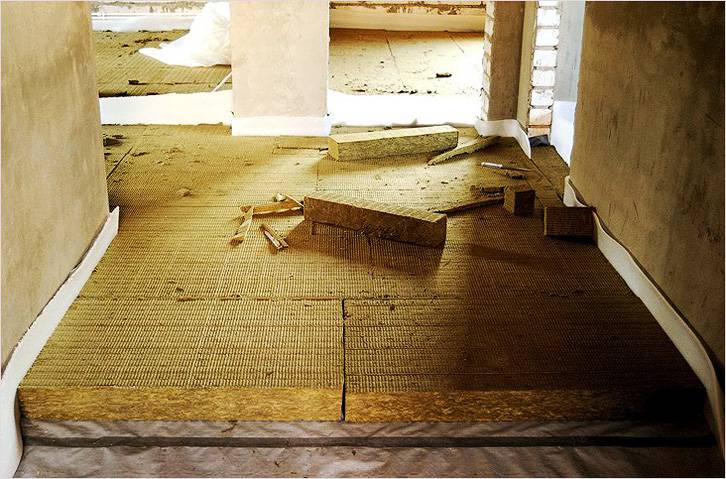

Laying mineral wool under the screed
Insulation stages using mineral wool do not differ from the previous ones. Only the laying technology differs depending on the underlying surface. So, for covering on compacted soil, mineral wool is tightly mounted between the logs. A rough or reinforced screed is laid on top. To cover on a rough screed or floor slab, a layer of vapor barrier material is placed on the bottom and top of the cotton wool layer, the joints of which are worked out with tape.
Concrete floating floor device
This type of soundproofing flooring is a solid, reliable, durable base.
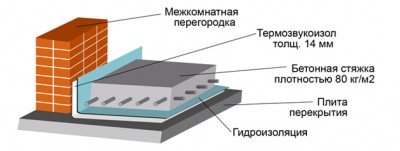

Concrete floating floors are used in rooms with significant floor loads - in warehouses, garages, parking lots. Also, this technology is suitable for the installation of a warm water floor, since it is important for it to have a good thermal conductivity of the upper layer of the structure.
The procedure for performing concrete floating floor technology:
- The base is cleaned, the irregularities are preliminarily eliminated - the grooves are closed up and the convex places get rid of.
- For the purpose of waterproofing, bituminous mastics are applied to the base or special dry mixtures are used.
- The edge tape is glued along the contour of the room.
- If mineral wool is used for the cushioning layer, then a vapor barrier must be laid on the base with the obligatory gluing of the joints.
- A cushioning material is laid on the prepared base, which is used as mineral wool or foam.
- A polyethylene film is placed on top of the cushioning layer, which will serve as a separating layer between the wet screed and the installed sound and heat insulation layer.
- Then a cement-sand mortar is poured, the quality of which can be improved with the help of special additives. A metal mesh is used to reinforce the screed.
Types of floors that need to be soundproofed
Soundproofing the floor helps to achieve the desired comfort. Foamed polyethylene and polypropylene, a universal insulation that is used in the arrangement of any kind of floor, be it wooden or concrete. A suitable insulation option is selected based on the type and load on the flooring.
For soundproofing the concrete floor under the screed in apartments, use "Stenofon-190 type A", with a density of up to 25kg / m3. And for rooms with suspended operational loads, it is better to use the foam-propylene "Stenofon NPP type A", which has a denser structure - up to 40 kg / m3.
Floating prefabricated floor technology
This type of flooring includes parquet or tongue-and-groove boards or laminates.
These coatings must be laid through the cushioning material on a flat base, since irregularities will lead to deformation of the material and their rapid failure. Minor imperfections, such as scratches, are allowed.
An insulating material is laid on the base, which, most often, is polyethylene foam with a uniformly closed cellular structure. Foamed polyethylene can be used for all types of floor coverings, and is presented in two types:
- physically cross-linked (or gas-filled) expanded polyethylene;
- chemically cross-linked polyethylene.
The second option is expanded polystyrene. The thickness of the insulating material is 2-5 mm.
The elements of the finishing floor covering are laid out with a distance of 10 mm from the wall. This gap is necessary so that when the coating expands under the influence of temperature, it does not swell, resting against the wall.
Prefabricated floating floors are least effective in terms of sound and heat insulation.
Do not fill, but collect!
Dry prefabricated screeds are widely used both in apartment renovation and in suburban construction. They have stood the test of time with honor, and now we can objectively talk about the advantages and disadvantages of the design, as well as the nuances of installation that affect its properties and durability.
As a rule, the finished floor should not be laid directly on the slab. The latter is rarely even enough for this, and in addition, it can poorly isolate sound and heat. To correct these shortcomings, a roughing layer is needed, a popular variety of which is dry screed.
A screed of this type can be performed in an apartment in two to three days (two installers collect an average of 30-40 mg of floor per work shift), and labor costs almost do not depend on the thickness of the layer. It does not require drying, is compatible with most floor coverings, perfectly insulates heat and noise - both shock and air. A dry screed saves money and is indispensable if you need to significantly raise the floor level or smooth out large irregularities. Construction standards (in particular, SP 29.133302011) recommend using it in cases where it is necessary to avoid wet processes and speed up the production of work.
EVERYTHING YOU NEED FOR THIS ARTICLE IS HERE >>>
But in order for the screed to cope with its task and not require repairs after several years, it is necessary to choose the right materials and prevent defects during installation.
Dry screed technology
A floating floor device of this type excludes the use of mortars. This method involves leveling the surface for the subsequent laying of the prefabricated floor. The difference between this technology of noise insulation from a concrete floating floor is that dry mixtures of fine-grained materials are poured onto the base, which are used as expanded clay or perlite sand.
Dry backfill allows you to quickly level the base on which the remaining layers are laid. This method is significantly cheaper than the technology of a concrete floating floor.
Dry screed stages:
- The subfloor is prepared by removing all old coatings. Slots and grooves are sealed with a solution prepared from a dry mixture. For this purpose, you can use "Remstream-T".
- Using a level - laser or water, mark the height of the filling.
- Between the wall and the future bedding, an edge tape is fixed, for the manufacture of which foamed polyethylene or mineral wool is used.
- Since the fine-grained bedding has a low moisture resistance, it is necessary, in order to create moisture protection, to spread a polyethylene film over the entire area with an overlapping edge of at least 250 mm. The edges are glued with reinforced tape.
- The bedding is placed up to the marked level, rammed.
- On the backfill, most often, gypsum fiber boards are laid in two layers, fastened together with glue.
This is one of the simplest options for dry screed technology.
If the initial task is to create reliable thermal protection, then expanded polystyrene or extruded polystyrene foam can be additionally placed on the bedding. If the main goal is sound insulation, then mineral wool is used. The maximum thickness of polystyrene used for these purposes is 100 mm.For noise insulation of the floor of the second and subsequent floors, as a rule, polystyrene foam plates with a thickness of 30 mm are used.
Laying sound insulation on a concrete base
This point must be approached especially carefully. As a rule, hollow-core products are used as floor slabs, and they can work as resonators, amplifying the sound.
To avoid this, you must:
- lay on the slab a moisture-proof polyethylene film with an overlap at the joints of about 150 mm. Glue the joints with tape. When laying, ensure the overlap on the walls to the height of the finished floor;
- install the logs to the desired height using brick linings (in case a wooden floor is used);
- pour a layer of expanded clay, taking into account the thickness of subsequent layers, carefully level and tamp;
- lay the second layer of moisture protection in the same way;
- lay a roll of insulation, glue the joints with tape;
- install a reinforcing mesh 50 x 50 mm at a height of about 20 mm above the expanded clay layer, using wooden pads under the mesh (chairs);
- install "beacons";
- screed the floor with a dry method under the topcoat.
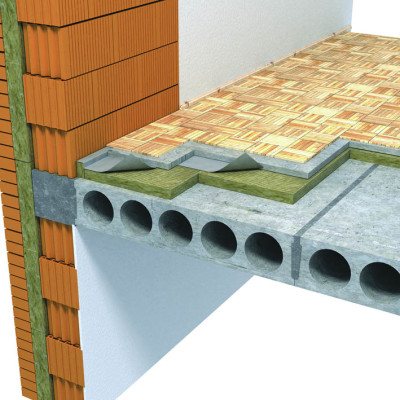

Fig. 5. Screed device over heat and noise protection
Tips & Tricks
- All wood used in construction must be treated with antiseptics and fireproofing.
- For all the importance of the financial side of the issue, choose the best option in terms of reliability and durability.
- Before making a decision, do not hesitate to consult with people who have already applied this or that option, which will help you find the right solution, taking into account the peculiarities of your own construction.
Helpful article? Bookmark it!
IT MAY BE INTERESTING FROM THE AUTHOR
Floor insulation
Choosing floor coverings for a water heated floor
Floor insulation
Izolon: features, types and common areas of application of the material
Floor insulation
Thermal insulation of the floor with expanded clay
Floor insulation
Installation of underfloor heating - instructions
Floor insulation
Warm floor under tiles - selection, installation
Floor insulation
Electric underfloor heating
Cork soundproofing underlays
The traditional options for soundproofing a floor is the use of a subfloor under the final floor covering, which performs three main functions: smoothing the surface of the base, soundproofing and thermal insulation.
Experts categorically do not recommend using foam materials as a sound-insulating substrate for linoleum, since their use can lead to marks on the floor even from not very heavy objects.
A practical underlay for laminate or linoleum is cork, which has a cellular structure. Small air bubbles trapped in the millions of cells in the cork structure ensure an even distribution of the load over the entire floor area. It is an excellent material for heat and sound insulation. In addition, the cork backing is resistant to high humidity in the room, which allows you not to worry about its possible deformation.
On the basis of natural cork chips, the following materials are produced for floor sound insulation:
- Sheets made of cork chips are not subject to decay, mold formation, and are not destroyed by rodents. This chemically inert material has a lifespan of at least four decades and can reduce noise levels by 12 decibels.
- The cork rubber backing is made from a mixture of granulated natural cork chips and synthetic rubber. Can be used under all types of floor coverings. Requires an additional moisture protection device using a polyethylene film. It has the highest noise-absorbing characteristics among cork materials - it reduces the noise level by 18-21 decibels.
- The bituminous cork substrate resembles roofing material with crumb sprinkling in appearance. Lay such a substrate with a bituminous layer upwards, with a cork downwards.Does not require additional waterproofing, the noise reduction level reaches 18 decibels. The main disadvantage is the difficulty in laying on the base.
Features of the
Sound insulation wool, more commonly known as mineral wool, is a material used to reduce the noise level entering a room. This material should not be confused with a sound-absorbing analogue, which absorbs noise inside the room, preventing it from spreading outside the room.
The basis of wadded insulation is long and flexible inorganic fibers obtained from quartz, basalt, limestone or dolomite.
The production process involves the melting of the stone base, after which fibers are drawn from it, which are then formed into threads.
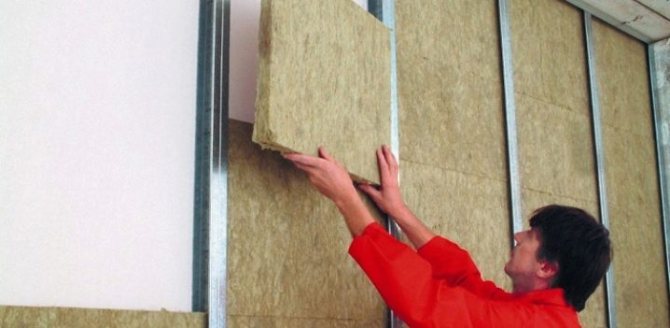

Soundproof sheets are formed from the threads, and the material is characterized by a chaotic arrangement of fibers. Numerous air "windows" are formed between them, due to which the soundproofing effect is achieved.
Wadded materials for sound insulation have the following technical properties:
- low thermal conductivity, which allows the use of cotton wool also as insulation;
- fire resistancedue to the stone base of the material;
- strength - we are talking about high strength characteristics not of a single fiber, but of a cotton sheet;
- deformation resistance, including when the material is compressed, heated or cooled;
- hydrophobicity, that is, the ability to repel water particles;
- durability - the service life of wadded soundproofing materials is on average 50 years.
Arriving home from work, I want to be in silence, and not listen to neighbors making noise, or rumbling of the doors of the entrance and the noise of cars. To avoid unnecessary noise, insulation is made. Soundproofing can be done on the ceiling, wall or floor. Many building materials can fulfill this role. Unfortunately, the sound insulation incorporated in the construction of a house is not always enough. But it can be strengthened. To do this, you need to close up all the cracks and holes and thickening of the floor.
Other types of materials for noise insulation
- The highest degree of sound insulation is provided by the material "Shumanet-100". With a thickness of only 3 mm, the level of noise reduction is 23 decibels, with a thickness of 5 mm - 27 decibels. The basis of such a substrate is fiberglass with a special weave. If a staple weave is used for the base, then the noise reduction level reaches 42 decibels. When laying these materials, a gap of 10 mm is left near the wall. It is designed to remove moisture.
- Heat and sound insulation Rockwool is made of stone wool. Basalt fibers can withstand temperature rise up to 1000? С without losing their qualities. Remaining intact at such high temperatures, basalt fibers are able to protect structures from fire. Due to its high fire safety, Rockwool can be used both in multi-storey buildings and in private housing construction for soundproofing a wooden floor. The basis of the high sound-insulating and sound-absorbing characteristics of the material is its ability to absorb sound waves in a wide frequency range. Versatility, durability, high fire resistance and affordable cost make Rockwool a popular material in the insulating building materials market. Rockwool Floor Butts are used in apartment buildings, Acoustic Butts are used for soundproofing the floor on logs.
Prices for materials for soundproofing the floor
If you are in doubt about which soundproofing for the floor to choose without prejudice to the family budget, see in the table the cost of the materials indicated in the article and some other materials (prices for March 2019 for Moscow), as well as the reviews below:
| Name | units rev. | Price |
| Sound-insulating substrate Vibrostek-V300 | r.m. | 150-170 |
| Akuflex, underlay for flooring, roll 15 x 1m, thickness 4mm | 1 PC. | 1650-1725 |
| Shumanet-100, roll 15x1, thickness 4 mm | 1 PC. | 3300-3450 |
| Shumoplast-soil | 1 kg. | 150 |
| Rockwool Floor Butts | 1 PC. | 660-799 |
Floor sound insulation: reviews
You can see a brief overview of the properties and use of materials for soundproofing the floor in an apartment in this video: Illiterate installation of even the most modern soundproofing materials can lead to a complete lack of effect from their use. Therefore, before starting work on soundproofing the floor with your own hands, it is advisable to consult a qualified acoustics specialist.
Choosing the right material
Sound-absorbing materials are divided into three types according to the level of severity:
- Soft ones have a felt base, are made of mineral wool or fiberglass.
- Semi-rigid - with a cellular structure.
- Hard - with granules of perlite, vermiculite or granulated mineral wool.
Sound-reflecting materials are considered to be stone, drywall, brick and concrete. However, by themselves, they will not protect against loud sounds coming from below.
If you are looking for a simple solution directly to the screed, choose the floating floor type. Plus - the range of building materials is larger. Minus - they dry for a long time.
The easiest way is to install soundproofing, then a suitable type of self-leveling screed. Noise insulation is mounted with a margin and is installed on the walls. There are no rigid connections with ceilings and walls.
Complex turnkey apartment renovation
- All inclusive The cost of repairs includes everything: work, materials, documents.
- Without your participation After agreeing on the project, we only bother the owners when they hand over the repairs.
- The price is known in advance The cost of the repair is fixed in the contract.
- Fixed repair time Turnkey apartment renovation in 3.5 months. The term is fixed in the contract.
More about Made
The quality of sound insulation depends on the type, thickness and structure of the material. Percussion and other noise levels can be adjusted up to 40 decibels if 4 to 20 mm insulation is used. Using acoustic insulating plates or shumoplast, you can get another 7-12 dB.
If laminate, parquet or other topcoat is to be laid, a sound-insulating substrate is used. There are domestic and foreign options on sale. The most affordable "Akuflex", "Vibrostek" -V300, their analogues.
The most common materials for heat and sound insulation
Foamed polyethylene
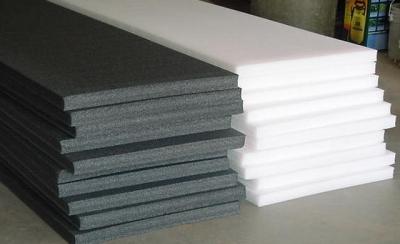

One of the most modern, efficient and inexpensive materials for thermal insulation. It is made from a high quality polyethylene compound, but has one feature - the presence of special air-filled pores. The characteristics of this material allow it to be used in different temperature ranges - from -40 to +90 degrees. At the same time, the air humidity can be maximum.
The versatility of polyethylene foam allows it to be used for insulating window openings, cracks between wall ceilings, when installing doors, etc. For the convenience of construction work, foamed polyethylene is produced in the form of rolls, in the form of tubes and cords. In addition to thermal insulation, it does an excellent job of waterproofing and sound insulation.
The main characteristics of polyethylene material: environmental friendliness, durability, versatility, elasticity, resilience, resistance to mechanical and chemical influences, low thermal conductivity and water absorption.

